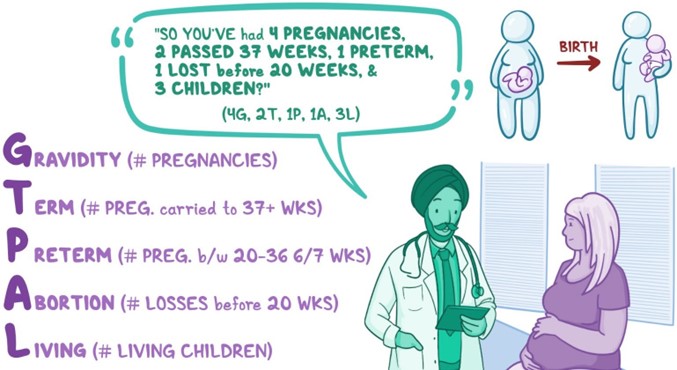When reviewing the causes of late postpartum hemorrhage, which of the following would the nurse identify as the most common cause?
Select one:
Retained placental fragments.
Cervical or vaginal lacerations.
Uterine inversion.
Uterine atony.
The Correct Answer is D
Choice A Reason: Retained placental fragments. This is an incorrect answer that refers to a different cause of late postpartum hemorrhage, which is less common than uterine atony. Retained placental fragments are pieces of placenta that remain atached to the uterine wall after delivery, which prevent uterine contraction and involution, and provide a source of bleeding and infection. Retained placental fragments can be caused by abnormal placentation (such as placenta accreta), manual removal of placenta, or incomplete separation of placenta.
Choice B Reason: Cervical or vaginal lacerations. This is an incorrect answer that refers to a different cause of late postpartum hemorrhage, which is more likely to cause early postpartum hemorrhage than late postpartum hemorrhage. Cervical or vaginal lacerations are tears or cuts in the cervix or vagina that occur during delivery, which can cause bleeding from the damaged blood vessels. Cervical or vaginal lacerations can be caused by rapid or instrumental delivery, large or malpositioned fetus, or episiotomy.
Choice C Reason: Uterine inversion. This is an incorrect answer that refers to a different cause of late postpartum hemorrhage, which is rare and life-threatening. Uterine inversion is a condition where the uterus turns inside out and protrudes through the cervix and vagina after delivery, which can cause massive bleeding and shock. Uterine inversion can be caused by excessive traction on the umbilical cord, fundal pressure, or uterine relaxation.
Choice D Reason: Uterine atony. This is because uterine atony is a condition where the uterus fails to contract and retract after delivery, which leads to bleeding from the placental site. Uterine atony is the most common cause of late postpartum hemorrhage, accounting for about 75% of cases. Late postpartum hemorrhage is excessive bleeding from the uterus or genital tract that occurs more than 24 hours but less than 12 weeks after delivery. Late postpartum hemorrhage can be caused by retained placental fragments, subinvolution of the uterus, infection, or coagulation disorders.
Nursing Test Bank
Naxlex Comprehensive Predictor Exams
Related Questions
Correct Answer is C
Explanation
Choice A Reason: 3-2-1-0-2. This is an incorrect answer that underestimates the number of pregnancies and overestimates the number of preterm births. The client has had four pregnancies, not three. She has had one preterm birth, not two.
Choice B Reason: 4-1-1-1-3. This is an incorrect answer that overestimates the number of living children. The client has two living children, not three.
Choice C Reason 4-1-1-1-2. This is because the GTPAL method is a way of summarizing a woman's obstetric history using five numbers: G (gravida), T (term births), P (preterm births), A (abortions), and L (living children). Gravida is the number of pregnancies, regardless of outcome. Term births are deliveries after 37 weeks' gestation. Preterm births are deliveries between 20 and 37 weeks' gestation. Abortions are pregnancies that end before 20 weeks' gestation, either spontaneously or electively. Living children are the number of children who are alive at the time of assessment.
Choice D Reason: 4-1-2-0-3. This is an incorrect answer that overestimates the number of preterm births and living children, and underestimates the number of abortions. The client has had one preterm birth, not two. She has had one abortion, not zero. She has two living children, not three.

Correct Answer is A
Explanation
Choice A Reason: Provide compassionate and accurate information throughout the process and support them to make their own decisions. This is a therapeutic strategy that demonstrates empathy, honesty, and advocacy for the couple. It also helps them understand their options, risks, benefits, and alternatives, and encourages them to participate in their care.
Choice B Reason: Inquire about the names they have chosen for their baby to get their mind off their stress. This is a non-therapeutic strategy that avoids addressing the couple's concerns, minimizes their feelings, and may create false hope or unrealistic expectations.
Choice C Reason: Express sympathy and provide directive advice to the couple about what they should do. This is a non-therapeutic strategy that shows pity, imposes personal values, and undermines the couple's self-determination.
Choice D Reason: Refer them to a marriage counselor in the same building to help them with the decisions. This is a non-therapeutic strategy that implies that the couple has marital problems, shifts responsibility, and may create resentment or resistance.
Whether you are a student looking to ace your exams or a practicing nurse seeking to enhance your expertise , our nursing education contents will empower you with the confidence and competence to make a difference in the lives of patients and become a respected leader in the healthcare field.
Visit Naxlex, invest in your future and unlock endless possibilities with our unparalleled nursing education contents today
Report Wrong Answer on the Current Question
Do you disagree with the answer? If yes, what is your expected answer? Explain.
Kindly be descriptive with the issue you are facing.
